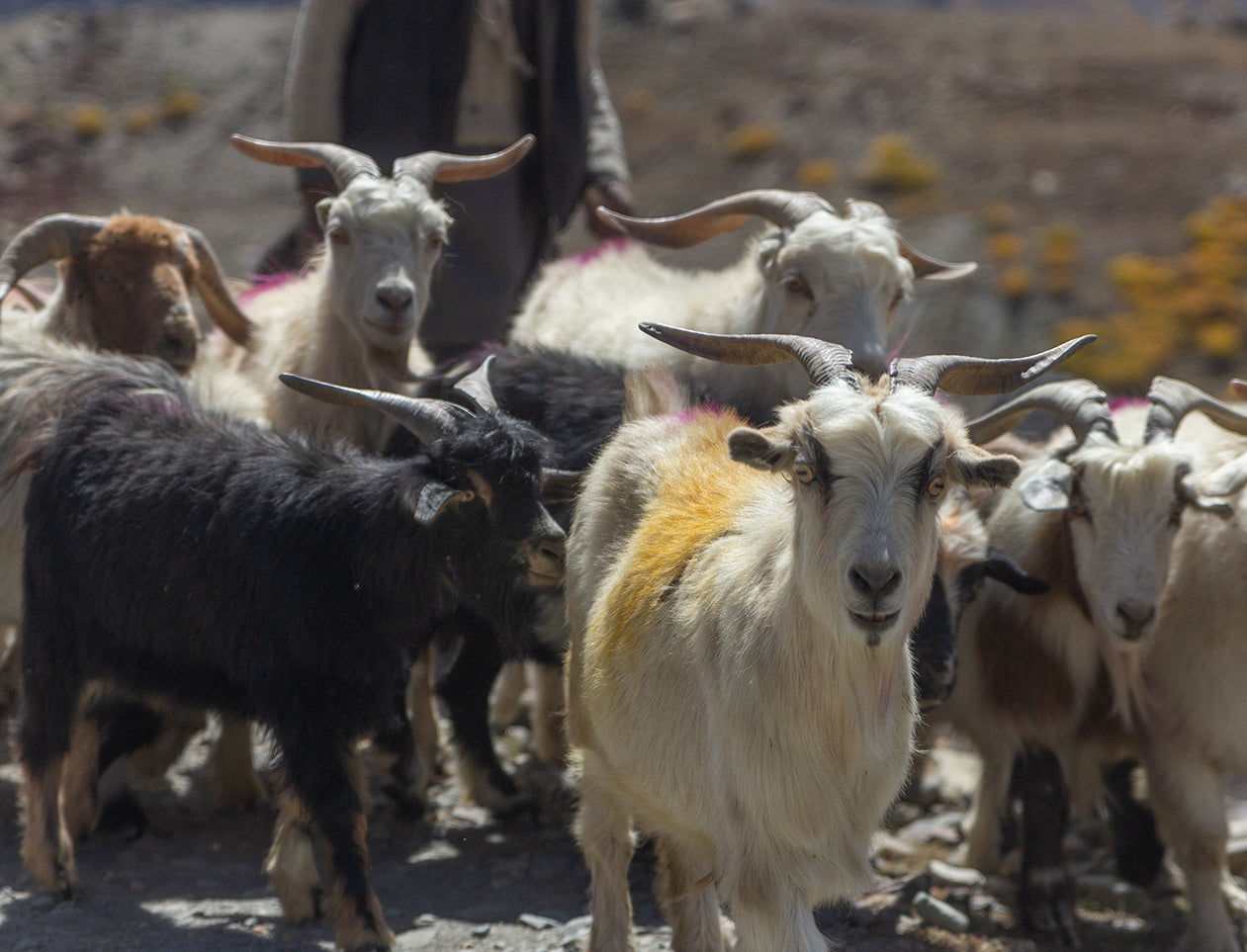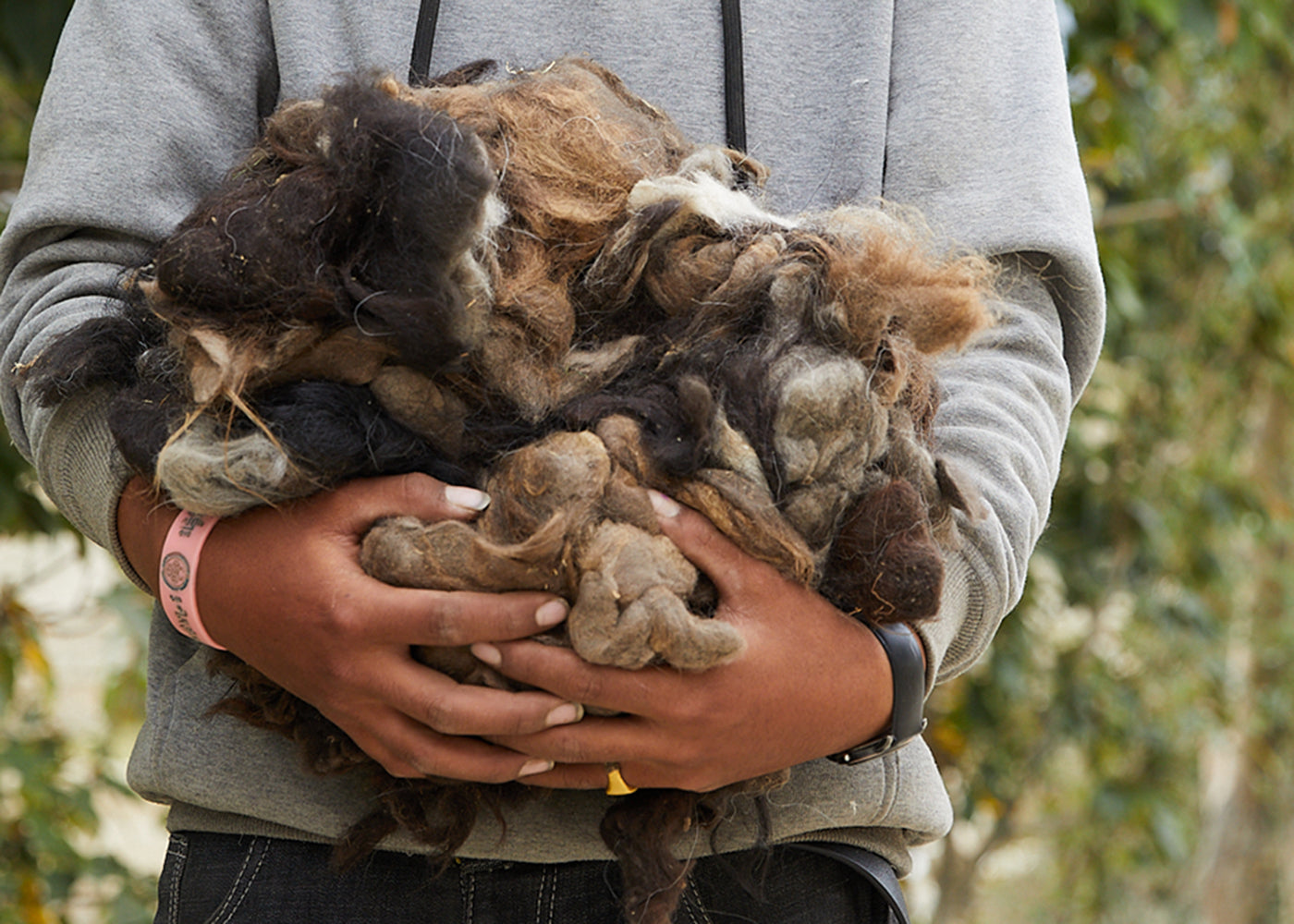
From nature, by hand – our materials
FROM NATURE, BY HAND – OUR MATERIALS AND DYES
People, genuine craftsmanship and original Himalayan, Indian and Norwegian materials.
Everything created by hand by local artisans in wild silk, yak wool, sheep wool, pashmina, linen and organic cotton.
Dyed with natural indigo, eucalyptus, walnuts, tea, flowers, leaves, bark, herbs and other natural extracts.
Nature's own elements spun, weaved and dyed by hand gives each of our products a very special and unique feeling. This is of course more time consuming and extensive than fast fashion industry processes, but we want to contribute to a new environmental mindset where craftsmanship can take its time.
Together with committed cooperatives and small manufacturers, we think long-term, pay homage to the original craft, and work ethically for the environment and the people.
We make a difference. SLOW FASHION is the future!
Every one of our products includes information regarding its materials and dyes. Here is more in-depth descriptions of these:
SHEEP, GOAT AND YAK WOOL
Wool from domestic animals has been used against wind and cold since time immemorial and is believed to be one of the earliest raw textiles ever used. It is a textile fibre that is combed or sheared from an animal. The wool is then prepared by combing or carding and then spun into yarn and thread. Wool can also be used for felting.
Since wool tends to rupture in a longitudinal direction, special wool handling us necessary. Different animal species have different types of wool. Wool coats usually consist of bottom wool and cover hair. The bottom wool is short-fibre and softer than the opaque one. Wool contains lanolin, a fat that covers the wool fibre and has antibacterial properties that prevent odour. That is why it is said that wool is self-cleaning and dirt-repellent.
Carefully care for your durable wool garment. Air out periodically and hand wash only when necessary with mild detergent.
SHEEP WOOL
After “man’s best friend”, the dog, the sheep is probably man’s earliest domesticated animal, closely followed by the goat. Different sheep breeds provide very different wools.
We work with a number of different types of sheep wool such as:
Tibetan Sheep Wool is long-fibred and very warm. As its name implies, it comes from sheep that graze at high altitudes on the Tibetan plateau. The wool is durable and becomes softer over time. Tibetan sheep wool is often blended with other fibres such as merino wool and silk.
Several of our shawls are made from sheep wool purchased directly from shepherds in Himachal Pradesh and the Kullu and Kangra districts.
Harsil Wool comes from the Garhwal region of Uttarakhand in the Himalayas.
MERINO WOOL
Merino is a domesticated sheep group mainly raised and kept for wool production. Merino sheep produce a very fine-fibre wool. Merino sheep are native to Spain. There is documentation of their existence since the 12th century. Today, this breed of sheep can be found all over the world. They are sociable animals and well-suited for semi-arid and nomadic grazing. They must be shorn at least once a year because their wool does not stop growing. Fine-fibre merino wool is often used for garments to be worn close to the body not only for warmth but also because bacteria do not thrive in it.
The merino wool used for many of our shawls comes from the plains of West Bengal, India. It is purchased directly from the shepherds of the Himachal Pradesh district.
PASHMINA WOOL
People often think that pashmina and cashmere refer to the same thing, but there is a clear distinction between the two in that these wools come from goats from different regions. Pashmina is made from the downy undercoat of the pashmina goat, a goat species living at 4000-5000 metres altitude in the Himalayas. The outermost coat is coarse, and the thinnest hairs are found in the innermost layer. In the spring, the goats naturally shed their undercoat, which regrows in winter. This undercoat is collected by combing the goat, not by shearing.
The undercoat is called "pashm" in Kashmiri, and this is where the word “pashmina” comes from. Pashmina is used to describe the finest cashmere. The fibres are incredibly thin. Each goat produces only 100-160 grams of underwool pashmina each year. The wool of ten goats is required to make one sweater.
YAK FIBRE WOOL
A yak is a long-haired ox that lives on high plateaus over 2500 meters throughout the Himalayan region of the Indian subcontinent, the Tibetan Plateau and as far north as Mongolia. There are approximately 14 million domesticated and 15 to 20,000 wild yaks grazing in mountain, forest and steppe landscapes. Yak wool is therefore a rare and exclusive product that has been used by nomads for thousands of years for their clothes, blankets, ropes and tents.
A yak’s large body is covered with thick hair suitable for the most extreme weather conditions. Yak fibre wool is as even and soft as cashmere and merino wool, but at the same time warmer than that of sheep wool. The yak loses its wool at regular intervals, and the fibres retain their natural antibacterial properties making it naturally odour resistant.
We often mix yak fibre wool with soft merino wool or silk to thin it.
We work with the couple, Ritika and Sharupa, in the Himachal Pradesh region of the Indian Himalayas. They make their purchases of yak fibre within a 200-kilometer radius of their district. They wash, prepare, spin, weave and dye the fine yak fibre with the help of local craftsmen and government-approved yak fibre producers.
SILK
Silk is a natural protein fibre. Its use for textiles originated in China around 7000 BC, and the tradition then spread to India and Japan. Silk is often fine and glossy, yet insulating and very, very strong.
There are many different types of silk based on how and where source larvae developed their cocoons. Another distinction is made between wild and "conventionally cultivated" silk. We primarily focus wild silk in our products.
WILD SILK
India produces four kinds of wild silk: mulberry, tussar, muga and eri. Wild silk can also be referred to as: AHIMSA, NON-VIOLENT SILK, PEACE SILK OR VEGAN SILK.
Silkworms are fed on mulberry leaves cultivated in plantations. Silkworms are also found wild on forest tree leaves. The combination of larva and leaf type results in different qualities. The cocoon is harvested by hand after the caterpillar has turned into a butterfly and left it behind. During its metamorphosis, the larva has eaten itself out of the cocoon causing threads to be torn into shorter lengths. It takes time an effort to spin such broken threads, thus adding to production expense of an already small-scale endeavour.
Wild silk has an uneven and sensitive structure which is all the more enhanced by spinning and weaving by hand.
TUSSAR SILK
Wild tussar (alternatively spelled as tussah, tushar, tasar, tassar) silk is produced in both India and China. Larvae feed on the leaves of tropical trees. The thread is coarser, more raw and more uneven than, for example, mulberry silk thread. Tussar silk is valued for its rich texture and natural deep gold colour.
ERI SILK
In Assamese, the language spoken in the city of Assam, era means castor. Eri larvae live in the wild eating the leaves of castor trees. They spin their cocoons which are then harvested by hand. The texture of the silk produced is coarse, fine, and dense. It is very strong, durable, and elastic. Eri silk is darker and heavier than other silks and blends well with wools and cotton. Due to its thermal properties, it is warm in winter and cool in summer.
Larvae develop naturally into a butterflies and leave their cocoons behind. Eri silk is therefore also referred to as Ahimsa silk, non-violent silk and vegan silk.
MUGA SILK
Muga silk is the finest and most exclusive silk of all India's wild silks. The cocoons are harvested in the wild from the leaves of the Lichia tree in the state of Assam, a region known for its silk craft since 3000-2000 BC. The silk is known for its extreme durability and has a natural yellowish-golden tint with a shimmering, glossy texture. It was previously reserved for the use of royalty.
We are very grateful to be able to offer this exclusive, unique silk also referred to as Ahimsa, the non-violent silk.
LINEN
Linen (or flax) is a fibre that is grown in colder climates around the globe. Textiles made from the flax plant are better known as linen in the western world. Going back several thousand years, linen is one of the oldest textiles ever used. Linen artifacts that are 30,000 years old have been found in Georgian caves; the material was used in both Mesopotamia and Egypt; and linen is also often mentioned in the Bible. Linen is very strong and absorbent, and dries fast. Because of these characteristics, linen is comfortable to wear in hot weather.
We source our soft, beautifully lustred linen from West Bengal, India. Skilled Himalayan craftspeople have spun and woven it by hand and then dyed it with natural flowers, leaves, bark, etc.
ORGANIC COTTON
The Yucatan Peninsula, Mexico is where the cotton plant was first cultivated by man 8000 years ago. Cotton was brought to Europe around the birth of Christ. These days,
organic cotton is grown in Peru, India and Africa and has been relatively easy to obtain since the beginning of the 2000s. In order to earn the name “organic” cotton, it is required that the cotton be grown without use of any chemical pesticides or artificial fertilizers. To avoid soil depletion, a cotton farmer also should switch between different crops from year to year.
We use the hand-woven organic cotton from Gujarat dyed with Ayurvedic methods for our Yoga mat and yoga garments.

